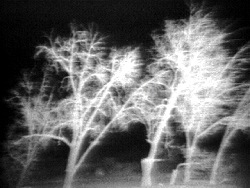Description
The Passing hauntingly travels the terrains of the conscious, the subconscious, and the desert landscapes of the Southwest, melding sleep, dreams and the drama of waking life into a stunning masterpiece. Viola, placed at the center of this personal exploration of altered time and space, represents his mortality in such forms as a glistening newborn baby, his deceased mother, and the artist himself, floating, submerged under water. Starkly yet poignantly rendered in black and white, The Passing re-enforces the notion of a permeable conduit between reality and surreality. An irrepressible soundtrack of Viola's labored breathing in sleeping and wakefulness serves to pull the viewer through an otherworldly topography. Amy Taubin of the Village Voice hails The Passing as "awesomely beautiful" and deems Bill Viola "a world-class video artist." She writes, "Some of the images... burst out of the darkness, shimmer and fade as radiant and ephemeral as shooting stars."
Production Managers: Donna Matorin, Kira Perov. Production Assistants: Donna Matorin, Robert Campbell. Engineering: Thomas Piglin. Funding: National Endowment for the Arts and ZDF Das Kleine Fernsehspiel.
Exhibition & Distribution Conditions
This work has been remastered to HD video by Bill Viola. The HD video is 16:9 aspect ratio, with black pillar bars on either side of the 4:3 image. This must be shown using a 16:9, HD display.
High-Definition Video Guide
SCREENING REQUIREMENTS for museum or gallery presentation:
The video should be presented as cinema. Projection in a dedicated, darkened gallery is strongly preferred. Accompanying floor plans and technical specifications regarding projection equipment is appreciated. Videos must be shown in original 4:3 aspect ratio, either using projector settings, as available, or pillarboxed with black masking.
Seating must be provided for the audience, and works must be shown according to a published schedule, not presented as an automatically repeating loop. Works cannot be incorporated into looping programs with other titles. Audio must be handled through a separate stereo sound system (amplifier and two speakers).
Please contact the EAI office (info@eai.org) for further information regarding monitor displays. Presentation on monitor may be permitted in certain instances, but the use of headphones or sound through built-in speakers is not permitted.
